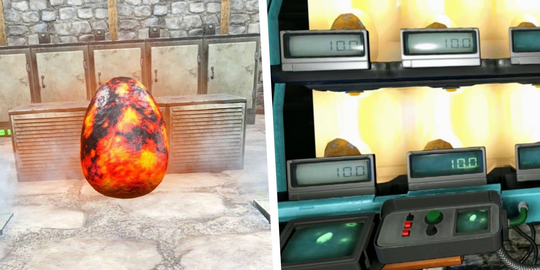How to incubate eggs in Ark: Survival Evolved
Keep your eggs warm and safe until they hatch, otherwise they're just going to spoil.


Published by Ethan @ PC Game Spotlight 2 years ago
You might be wondering how you even get your hands on a fertilized egg, given that many creatures can’t mate in Ark. Well, it’s quite simple. All creatures belong to a species, and most species are able to reproduce. Mammals are the exception to this rule and can’t lay eggs, but they have the ability to mate and have babies. As mentioned, however, you need to make sure certain criteria are met before attempting to incubate your egg.
Ark: Survival Evolved incubation requirements
You can see what the criteria are for each creature below:
Take note that each of these criteria have to be specifically followed – animals following you won’t impact the incubation process, but they mustn’t be riding on you. Mating too recently just means the egg won’t get fertilized – it doesn’t mean that the mating itself doesn’t work.
Egg types
Many of the creatures in Ark can lay eggs, whereas their mammalian counterparts can mate and have babies, but they can’t lay eggs. Normally, this is because the creature is non-mammalian. However, some mammalian creatures do have the capability to lay eggs, though they don’t intentionally do so in the wild. Human Bases consist of mostly domesticated creatures, so you may see them lay eggs.
Can I have eggs outside?
Although some of the above information seems to indicate that eggs can only be laid in an incubator, this isn’t the case. Many creatures are happy to spontaneously lay eggs, which can then be incubated. This can be useful if you’re farming eggs rather than taming the adult creatures themselves, but keep in mind they won’t be fertilized. Wild creatures won’t lay any eggs, which is a good way of knowing they’re not producing offspring – this also means that eggs can’t be laid on Beaches.
Incubating eggs in Ark
Obviously, if you plan to hatch your eggs, you need somewhere to incubate them. This is a fairly straightforward process, though it does need to be done very carefully. Make sure that the area maintains a steady temperature, which can be achieved through campfires and torches. Maintaining a steady temperature is crucial, but rainfall and snow can cause this temperature to drop, meaning you may have to take extra care to keep the fire going. Of course, make sure your fire pit is free from flammable materials, otherwise you may find that your eggs go up in flames.
You’ll also need to keep the egg somewhere safe – this can be challenging, given that a single drop can cause it to become damaged, ruining your egg. If you want to incubate without building anything, the best option is to place the egg inside a building. However, if you can’t be bothered to bring in the building, you can simply keep the egg in a box. Much like the temperature, it can be challenging to keep an egg safe from the environment without being too careful with it, so be extra cautious.
As the egg incubates and grows, you will constantly need to feed it organic material to keep it healthy. The egg will need to be fed every six minutes, so make sure you keep this in mind when planning the egg’s incubation chamber. Feeding the egg constantly is certainly good for its health, but continuously dropping it will mean completely neglecting it and wasting time.
How long does egg incubate for?
As mentioned above, the egg will grow larger as it incubates, but the amount of time this takes will depend on the ambient temperature. As you’d expect, keeping the egg in a warm area means it’ll be ready faster than in a cold area. There’s no easy way of tracking exactly how long the egg will take, but we can estimate that eggs in warm areas incubate faster than those in cold areas.
Once your egg is ready, it’ll inevitably crack, with a baby creature crawling out. Congratulations! You’ve done the hard work and your baby is now ready to lead a lonely existence in this harsh, post-apocalyptic world.













